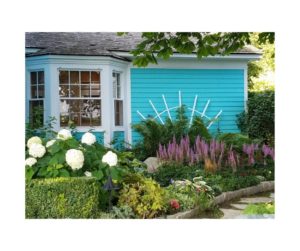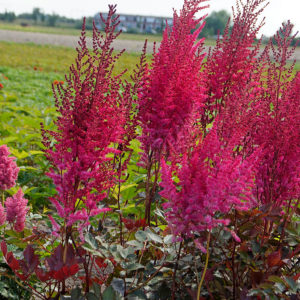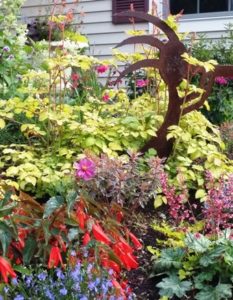ASTILBES FOR SUN AND SHADE
 Astilbes are rockstars that should be invited to perform in your garden! How can you not love their lush flower plumes that range in color from white, cream, pink, red, purple, peach, and lilac? Flower heights vary greatly, from 6” to 4’. Astilbes are deer resistant, flower in sun or shade, and are ignored by insects or diseases. They appreciate an organically-rich soil, which can be provided by working compost into the planting holes or applying it around the base of the plants. The only thing Astilbe ‘frown on’ is drought. Dry, hot spells may cause their leaves to get crispy. Incorporating organic matter into the soil, as well as mulching the garden, will help conserve moisture.
Astilbes are rockstars that should be invited to perform in your garden! How can you not love their lush flower plumes that range in color from white, cream, pink, red, purple, peach, and lilac? Flower heights vary greatly, from 6” to 4’. Astilbes are deer resistant, flower in sun or shade, and are ignored by insects or diseases. They appreciate an organically-rich soil, which can be provided by working compost into the planting holes or applying it around the base of the plants. The only thing Astilbe ‘frown on’ is drought. Dry, hot spells may cause their leaves to get crispy. Incorporating organic matter into the soil, as well as mulching the garden, will help conserve moisture.
 There are 18 species of Astilbe, four of which are commonly sold at garden centers in the Northeast for their superb performance in our climate: arendsii, chinensis, japonica and simplicifolia. The chinensis group is known for being the most drought tolerant. These are the best to use in full sun or where root competition from shrubs or trees is a factor. (pictured below Astilbe ‘Mighty Chocolate Cherry’)
There are 18 species of Astilbe, four of which are commonly sold at garden centers in the Northeast for their superb performance in our climate: arendsii, chinensis, japonica and simplicifolia. The chinensis group is known for being the most drought tolerant. These are the best to use in full sun or where root competition from shrubs or trees is a factor. (pictured below Astilbe ‘Mighty Chocolate Cherry’)
Astilbes flower for about three to four weeks and are divided into early, mid and late season bloomers. By combining some of each, you can have stunning color from mid-June to mid-August. Early cultivars start flowering in June (i.e., ‘Fanal’); midseason open in July (i.e., ‘Maggie Daley’), and late season bloom from late July into August (i.e., ‘Purple Candles’ and ‘Pumila’).

Astilbe partner well with Hosta, Japanese Forest Grass (Hakonechloa), Aralia ‘Sun King’, Lamium, Siberian Bugloss (Brunnera), Coral Bell (Heuchera) and Foamy Bells (Heucherella)
